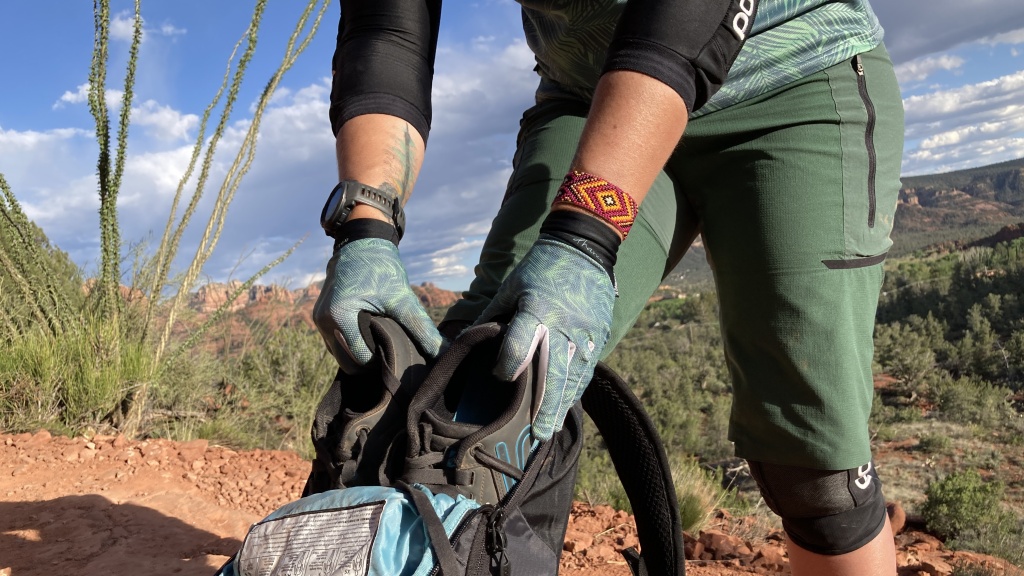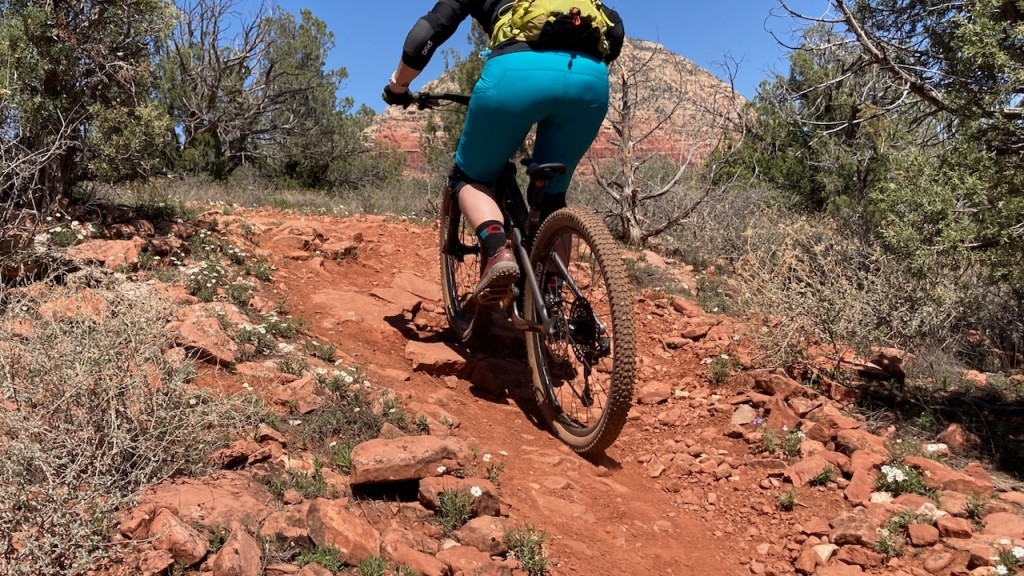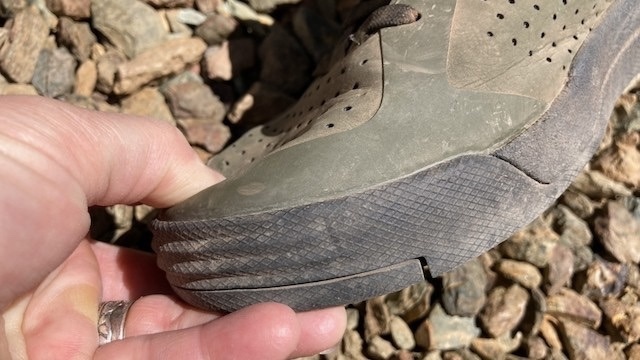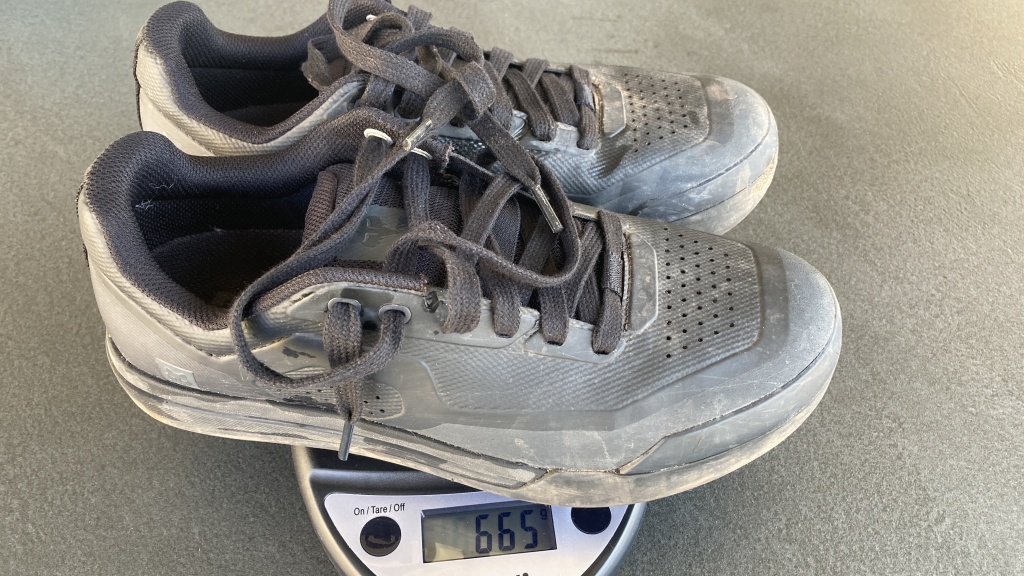When you choose a new women's flat pedal mountain bike shoe you want to think about factors such as how much protection you need, how grippy you like the connection between your sole and shoe to be, what your budget is, what type of riding you do, and how breathable you need your shoes to be. We tested 11 pairs of the newest and top-rated flat pedal mountain bike shoes to help you find the best shoe for you.
During our testing we evaluated each shoe in our six metrics, weighing them, comparing materials and construction, flexing the soles, and more. We looked for similarities and differences between shoes and on more than one occasion wore a different shoe on each foot which helps us to determine differences in power transfer, grip, and breathability. During our testing, we examined six different metrics: grip, comfort and protection, rigidity and power transfer, breathability, durability, and weight. Read on to learn more about how we scored each metric.
Grip
Many companies have proprietary rubber compounds on their outsoles, while others have partnered with long-standing rubber companies to create the outsole of their shoes. Each company's rubber compound has a different tread pattern and amount of grip, ideally designed to maximize the connection between the shoe's outsole and the pins and body of the pedal.
We began our grip testing by examining the shoe's outsole, commonly called the sole, feeling how hard the rubber is and examining the tread pattern. Next, we place our foot on the pedal to see how easily we can find our preferred foot position and how easily we can adjust our foot position. We then pedal backward, noting how well we could control the pedal with our foot, considering if we could maintain contact with the pedal on the upstroke. Finally, we take to the trails, noting how well our feet stay in place on technical climbs, descents, corners, jumps, and drops, documenting how well the shoe grips in each type of terrain. As much as possible, we ride each shoe on the same trails to minimize variables and ride each shoe with at least three different brands of pedals to account for variabilities in grip, pin type, and placement. When the weather permits, we ride through creeks, streams, and puddles to see if the grip changed after getting wet. Overall, shoes with the best balance of these factors earned the highest score in this metric.
Comfort and Protection
Comfort is subjective as everyone's foot has a different shape and volume, and everyone has personal preferences regarding comfort. We do our best to consider the features that companies tout as increasing comfort, such as molded footbeds, the width of the toebox, heel cups, lining, and upper materials, and more. We examined the shoe's sizing, as there is a relative sizing standard with some deviation between brands. We also review each company's sizing chart and read reviews to determine the best size to order based on our personal shoe size. In most cases, the sizing is the same as expected, and we noted when we needed to size up or down for an ideal fit.
Next, we look at the shoe's internal volume and width to determine if it would fit a variety of foot shapes and sizes. Some newer shoes have a much lower volume than models from a few years ago. We also consider the shoe's footbed and note any pressure points, hot spots, or circulation issues with the shoe while riding and how comfortable the shoes are on extended rides and while hiking.
The shoe's midsole is important in dissipating trail forces before they reach your feet. The midsole also helps increase the connection between your pedal and shoe. We gauge how well each shoe absorbed trail forces and impacts. This is especially noticeable on fast, chunky descents and landings from drops. Companies add impact zones to the footbeds, toes, and heels to help protect the rider's foot. Some even include reinforcement along the medial collar (ankle) for stability and protection and gusseted tongues or gaiters to keep dirt and debris out of the shoe. Shoes scoring high in comfort and protection earn the highest marks, and we note when a shoe offers more protection and what applications it may be best suited for.
Rigidity and Power Transfer
Rigidity is how much flex the shoe has underfoot and correlates to a shoe's power transfer. More rigid shoes generally allow the rider better power transfer into the pedals. However, a delicate balance exists between being too rigid and too soft. The type of terrain you ride can also influence how rigid you want your shoes to be. Our testing includes cross-country, trail, and all-mountain/enduro riding. Shoes made for specific applications generally score better on those types of trails and lower in other applications. For instance, a gravity shoe may score higher at a bike park and lower on a cross-country trail. We tried to gauge how well we could transfer power from our foot into the pedal and, ultimately, into the crankset. In many cases, that effort directly correlates to the shoe's weight. At times, we also wore two different shoes on our feet for a side-by-side power transfer analysis.
We flex each shoe underhand to see how rigid the outsole and midsole are and where the flex point is. Some shoes flex easily underhand, while others are stiffer. Some flex closer to the toes, while others flex closer to the ball of the foot. We also hike in each shoe to gauge its rigidity. Lastly, we wear each shoe on various trails to see how its rigidity affects our ability to stand up on the pedals and apply pressure to them. Shoes with the best power transfer blend and rigidity or stiffness score highest in this metric. In our analysis of each shoe, we'll discuss its power transfer and rigidity.
Breathability
Our testing occurred in a variety of temperatures and conditions. In Minnesota, temps ranged from the low 50s to the mid-90s with dew points in the 60s. In the desert of Arizona, we rode in temps ranging from the 30s to the low 90s at elevations ranging from 3,500 to 6,000 feet with lots of sun. We found that riding hot temperatures and in direct sunlight with no shade can quickly make one aware of how well a shoe breathes and how quickly the uppers trap heat. These different temperatures and humidity levels all help us determine how well each shoe breathes.
All shoes have some type of ventilation, be it the upper itself, perforations, mesh panels, or a combination of materials. In general, shoes with more protection are less breathable because of the additional materials needed to reinforce or protect different areas of the shoe. Lighter-weight shoes are typically more breathable than their heavier counterparts. While testing, we quickly noted if our feet felt hot or sweaty, and even felt how damp our socks were after a ride to determine breathability. Shoes with the best breathability scored highest in this metric.
Durability
It's hard to discern a shoe's long-term durability over nine months of combined testing, but we try to replicate long-term use by riding a lot. We have also added notes on the long-term durability of shoes that our testers have worn beyond the test period.
We can't control the weather, and in some areas, trails close for snow and rain, so we try to replicate riding in various weather conditions as our local areas permit. We ride various terrain, knowing that rocks, sand, and water may cause the shoe to wear differently than on a smooth, dirt trail. We also guided and coached in our shoes and did several hike-a-bikes to get to the fun lines to see how they held up. We examined the soles after our test period, looking for scarring, holes, cuts, and tears, and looked at seams and stitching, uppers for delamination, torn threads, holes, and more to provide you with a general idea of how durable we think they will be in the long term.
Weight
Weight affects foot fatigue and your ability to spin the pedals and is the easiest metric to score. Each pair was placed on a kitchen scale and weighed in grams. Shoes weighing the least scored the highest, while the heaviest shoes scored the lowest.










